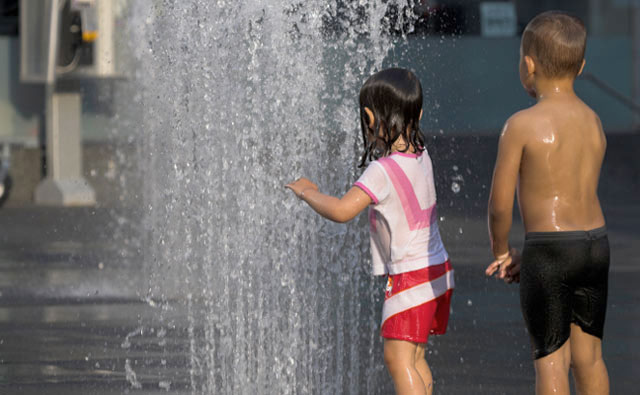My best childhood memories all seem to be summer related – and I don’t think I’m alone! Family vacations, hours in the pool, tennis, outdoor games with my friends, and of course –no school!
All that fun in the sun can spell danger for children. Compared to adults, children are fundamentally different in how they handle heat. Understanding these differences is crucial to keeping kids healthy and performing their best in the heat.
Adults cool off by sweating. When the air temperature is higher than body temperature, sweat evaporates and cools the skin. Kids sweat less than adults in absolute and relative terms. Adults also start to sweat at lower body temperatures than children, putting children at an increased risk of overheating.
Kids have a higher skin surface area to body mass ratio than adults. In fact, a ten year old child can have a skin surface area to body mass ratio as high as 32% greater than that of an adult. Rather than sweating, children cool off by dissipating heat through increased blood flow to the skin. This gives kids is an advantage in neutral or warm temperatures, as it allows them to conserve body fluids and maintain normal body temperature. But when the air really heats up, the greater surface area of their skin causes them to absorb more heat.
When a child exercises in the heat, he has a higher heart rate and pumps less blood through his body per minute compared to an adult. This not only compromises his ability to cool off, but it also puts a big strain on the cardiovascular system.
 Don’t Sweat it!
Don’t Sweat it!
Just because it’s hot outside, it doesn’t mean the kids can’t have fun. Here are some tips to beat the heat this summer:
• Take frequent breaks in the shade
• Place cold towels and ice packs on the skin
• Use a spray bottle with cold water
• Use a small, portable fan
• Wear loose fitting, light colored clothes. Shorts and short sleeve shirts are best. Kids cool by dissipating heat from the skin, so don’t cover it all up with long sleeves and jeans!
• Make sure to use sunscreen.
• Hydrate at least every 10 minutes with cold liquids, especially water. Dehydration can raise children’s core body temperature.
What are some of the strategies you use to beat the heat when working with kids?
In part 2, we’ll talk about hydration and how it relates to heat stress, as well as some tips to get kids to drink the right stuff in the right amounts.
Craig Valency, MA, CSCS, president and co-founder of SPIDERfit, has been a personal trainer for the last 11 years. He is currently working at Fitness Quest 10 in San Diego, an elite personal training and athletic conditioning facility. He specializes in youth strength and conditioning programs that promote physical literacy, injury prevention and optimal performance. Along with training youths from 6 to 18 years of age for general fitness, Craig has also worked with some of the top junior tennis players in the world. He has been a physical education consultant for the Stevens Point school district in Wisconsin for the last 3 years, helping revamp the district wide programming for the K-12 PE curriculum. Craig earned his bachelor degree from UCLA, and Masters Degree in Kinesiology from San Diego State University.






Connect with SPIDERfit!